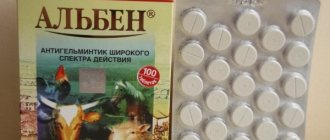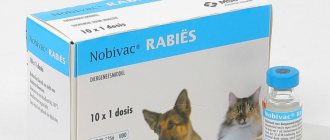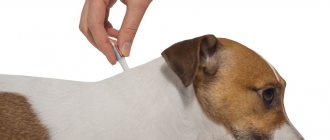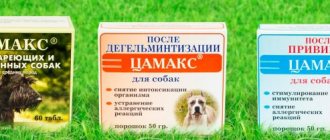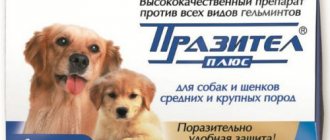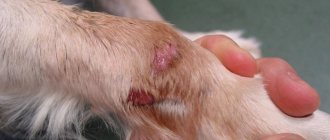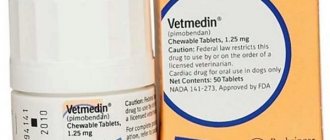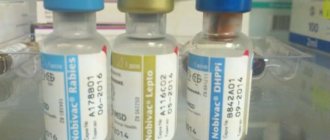Forticarb for dogs is used to prevent or treat the seasonal disease piroplasmosis (babesiosis). The product is available in the form of a 5% or 10% solution intended for injection. Only the five percent preparation is suitable for dogs.
Before using anti-Babesia medication, it is recommended to consult a veterinarian and carefully study the instructions for use.
Pharmacological properties of the drug "Forticarb" for dogs
Forticarb is active against Babesia, Franciella and Anaplasma
in domestic animals, as well as Ehrlichia canis in dogs.
When administered subcutaneously or intramuscularly, forticarb is quickly absorbed and penetrates into the tissues and organs of the animal's body. Forticarb is practically not metabolized in the animal's body and is excreted unchanged.
Forticarb is sometimes used to treat ehrlichiosis in dogs, hepatozoonosis in dogs, cytozoonosis in cats, and babesiosis in cats. The active substance of forticarb is imidocarb dipropionate. When imidocarb dipropionate is prescribed to treat ehrlichiosis in dogs, hepatozoonosis in dogs, cytazoonosis in cats and babesiosis, this is called off-label treatment. Many drugs are commonly prescribed for off-label uses in veterinary medicine. In these cases, follow your veterinarian's directions and warnings very carefully, as their directions may differ significantly from those on the label.
Purpose
Forticarb is prescribed for the prevention and treatment of piroplasmosis. This life-threatening disease can occur in acute or chronic form. Pathogens – protozoan microorganisms of the Babesia species – enter the dog’s body through ixodid tick bites. A dog can “catch” a parasite while walking. Insects are active from spring to autumn, so piroplasmosis is considered a seasonal disease.
Once in the blood, Babesia destroys red blood cells. The breakdown of hemoglobin leads to the formation of toxic products. Internal bleeding occurs. If you go to a veterinary clinic immediately after a tick bite, you can identify the disease at an early stage and avoid the death of your pet.
Piroplasmosis can occur in acute or chronic form. In the first case, the dog experiences food refusal, apathy, shortness of breath, and a rise in temperature. The mucous membranes become pale or yellow. Urine changes color. After a few days, the condition returns to normal, then the body temperature drops sharply and the animal dies.
The disease can become chronic in dogs with good immunity. The disease can last up to 3-6 weeks; after a course of therapy, all symptoms will disappear completely in 2-3 months.
Important! A caring owner should carefully examine the dog after a walk for the presence of ticks. This is especially important in regions with high rates of babesiosis.
Instructions, doses and method of use of forticarb in dogs and cats
According to the instructions for use of the drug, forticarb is administered to dogs with piroplasmosis once subcutaneously or intramuscularly at a dose of 4.0 mg/kg of animal body weight. 1 ml of forticarb 5% contains 5 mg of imidocarb (doses are given in Table 1). In the case of a control examination of blood smears one day after the administration of a 5% Forticarb solution and detection of piroplasms in them, the drug is re-administered in a standard dose.
Table 1 - Doses of forticarb 5% in dogs
27 70
| Weight | Drug dose 5%, ml | Weight | Drug dose 5%, ml | Weight | Drug dose 5%, ml |
| 1 | 0,08 | 11 | 0,88 | 30 | 2,4 |
| 2 | 0,16 | 12 | 0,96 | 32 | 2,56 |
| 3 | 0,24 | 13 | 1,04 | 35 | 2,8 |
| 4 | 0,32 | 14 | 1,12 | 37 | 2,96 |
| 5 | 0,4 | 15 | 1,2 | 40 | 3,2 |
| 6 | 0,48 | 17,5 | 1,4 | 45 | 3,6 |
| 7 | 0,56 | 20 | 1,6 | 50 | 4 |
| 8 | 0,64 | 22 | 1,76 | 55 | 4,4 |
| 9 | 0,72 | 25 | 2 | 60 | 4,8 |
| 10 | 0,8 | 27 | 2,16 | 70 | 5,6 |
Reviews from veterinarians
Alexei. Forticarb is a good remedy for Babesia, but I would not recommend getting carried away with it for prevention purposes. Its validity period is 15-30 days, which means that the dog will have to be injected more than three times during the season. And the drug is toxic. I recommend it in cases where there is a wave of illnesses and there is no opportunity to change the place of the walk.
Anatoly. I often use Forticarb in spring and autumn. Together with restorative procedures, it gives a good effect. I recommend that hunters keep it in their first aid kit when going out, but at the first opportunity you need to show the dog to a veterinarian.
Use of forticarb in cats
According to a study (Lappin MR et al, 2019), imidocarb dipropionate was administered twice at a dose of 5.0 mg/kg by intramuscular injection at an interval of 14 days to eight cats with chronic subclinical hemobartonellosis. No side effects or toxicity have been established. The dosages of the drug are indicated in Table 2.
Table 2 - Forticarb dosages for cats
| Weight | Drug dose 5%, ml |
| 0,5 | 0,05 |
| 1 | 0,1 |
| 1,5 | 0,15 |
| 2 | 0,2 |
| 2,5 | 0,25 |
| 3 | 0,3 |
| 3,5 | 0,35 |
| 4 | 0,4 |
| 4,5 | 0,45 |
| 5 | 0,5 |
| 5,5 | 0,55 |
| 6 | 0,6 |
| 6,5 | 0,65 |
| 7 | 0,7 |
| 7,5 | 0,75 |
| 8 | 0,8 |
According to the instructions for use of the drug, it is possible to use forticarb in dogs and cats for prophylactic purposes, in case of attack (or risk of attack) by ticks. Forticarb is administered once subcutaneously or intramuscularly at a dose of 4.0 mg/kg of animal body weight. The protective effect is observed within 10-14 days.
Storage conditions
In order for the drug to be truly effective and safe for the dog itself, all storage conditions must be strictly observed:
- The drug belongs to list B, and therefore its storage location must be securely isolated from access by children, pets and other outside interference.
- Storage temperature must be maintained between 0° and 25° Celsius. Freezing is not allowed. Long-term storage at temperatures above 29° Celsius is strongly not recommended, as in this case the drug decomposes into its constituent components.
- The same applies to the effect of direct sunlight: UV radiation is very harmful to the medicine; prolonged exposure can lead to a rapid loss of its medicinal effectiveness and/or the transformation of some components into toxic ones.
- The shelf life is exactly two years from the date of issue.
Are there potential side effects?
Dogs:
The most common side effects in dogs include pain during injection, drooling or drooling, clear fluid coming from the nasal cavity, and brief episodes of vomiting. Less common side effects include shortness of breath, diarrhea, swelling at the injection site, and restlessness. Rarely, a wound may form at the injection site.
Cats:
The most commonly observed side effects in cats are drooling/drooling, lacrimation, vomiting, diarrhea, muscle tremors, restlessness, rapid heart rate, and difficulty breathing.
If side effects of drooling or nasal discharge are severe, contact your veterinarian.
Contraindications
Manufacturers claim that taking Forticarb almost never causes negative reactions from the animal body. However, the medicine should not be given if there is an individual intolerance to its components. In practice, there are cases of an allergic reaction to a medication, manifested by:
- itching;
- rash on the skin;
- anxiety;
- nausea and vomiting;
- increased salivation.
Important! Taking Forticarb can cause anaphylactic shock and Quincke's edema, so you should not use the medicine for self-medication, and at the same time the doctor prescribes antihistamines.
When the medicine is administered, the parasites quickly die, which can lead to severe intoxication of the body, so injections can only be given under the supervision of a veterinarian. How severe the poisoning will be depends on the degree of development of the disease, therefore, in severe cases, infusion (in the form of a dropper) administration of drugs and symptomatic treatment are used.
general information
For mechanical damage to the skin in dogs, complex therapeutic ointments are used. More often they contain 2 or more components. Depending on the composition, they eliminate factors that slow down skin restoration and provide several therapeutic effects:
- Disinfectant – protect the wound from infection.
- Antibacterial - destroy harmful bacteria when suppuration begins in the wound.
- Anti-inflammatory – soften the symptoms of inflammation.
- Pain reliever – reduces pain.
- Regenerating – stimulate the formation of new cells to replace damaged ones.
Each drug has its own method of use, it is described in the instructions. But there are general processing rules:
- Before applying the treatment, the wound is thoroughly washed with soapy water to remove dirt, blood, necrotic particles, and pus.
- Be sure to treat with an antiseptic, for example, Chlorhexidine, Miramistin, Argumistin.
- The hair around the damaged area is cut to 1–2 cm.
- On superficial wounds, abrasions, and scratches, the ointment is applied in a thin layer without a bandage. If the dog licks the treated area, wear an Elizabethan collar until it heals.
- Bandages are applied to open wounds and deep injuries. To do this, a gauze swab is impregnated with a medicinal agent and fixed with a bandage. The dressings are changed 1-2 times a day.
- Fresh, uninfected lesions are treated from the center to the periphery. Purulent, inflamed - from the edge to the center, covering 1 cm of healthy skin.
If the wound does not heal for a long time, pus appears on the surface, the edges become hot, and veterinary attention is needed. It is possible that hygiene was compromised during processing and the dog will need a course of antibiotics.
Breeders reviews
Breeders and veterinarians advise using Forticarb only for treatment.
Marina, Malamute breeder. The nursery is located in a forest area, so I use Forticarb regularly. The other day we removed ticks from three dogs and decided to play it safe, although there were no obvious symptoms. Two dogs tolerated the injection well, and the third showed an allergy. The poor thing was rushing around the enclosure, barking, whining, his tongue hanging out, his eyes bulging. They barely pumped it out. I believe that you should inject Forticarb only in case of urgent need and you should have everything you need to relieve an unexpected reaction.
Victoria, breeder of Western European Laikas. Several times I discovered symptoms of piroplasmosis in dogs. I used Forticarb. It is the least toxic. After the injections, I always give the dogs hematogen and karsil. Tests show that even after the second injection there are no changes in the liver.
Cytoderm
Regenerating ointment for animals based on three active ingredients:
- Glycolan. Destroys pathogenic microorganisms, strengthens the protective barrier, stimulates healing.
- D-panthenol. Restores skin integrity, softens, moisturizes.
- Vitamins A, E. Accelerate recovery, prevent scar formation.
Cytoderm helps with any type of skin damage - wounds, abrasions, bruises, burns, frostbite, scratching. Quickly heals cracks on the surface of paw pads, reduces irritation on the paws from reagents, improves the condition of the mammary glands in nursing dogs.
Cytoderm is rubbed into problem areas 2-3 times a day until the tissue is completely restored. Price 370 rub.
Description
Forticarb 5% solution for injection is an anti-babesia drug for the treatment and prevention of blood parasitic diseases in dogs.
Forticarb 5% solution for injection contains 50 mg of imidocarb in the form of dipropionate as an active ingredient in 1 ml, and polyvinylpyrrolidone, benzyl alcohol, propionic acid and water for injection as excipients.
Forticarb 5% solution for injection is a clear, light yellow liquid in appearance.
Forticarb 5% solution for injection is available in 10 ml packages in the form of a sterile, clear, light yellow solution in 10 ml glass or plastic bottles.
Dorogovaya balms
Veterinary ointments containing medicinal complexes ASD-2F and ASD-3F. The abbreviation ASD stands for Dorogov's antiseptic stimulant.
ASD medicinal complexes contain biologically active substances with healing properties:
- antimicrobial;
- anti-inflammatory;
- wound healing;
- regenerating;
- immunomodulatory.
The composition contains additional useful components that have a beneficial effect on damaged skin - olive and castor oil, chamomile extracts, calendula.
Dorogova's balms are produced according to three recipes No. 4, No. 6, No. 10. They are identical in composition, but differ in the concentration of ASD - 4%, 6%, 10%, respectively.
The first two recipes are used for dogs:
- Balm 4% is prescribed for the treatment of superficial wounds not complicated by infection, scratches, scratches.
- Balm 6% is used to treat purulent wounds and dermatitis, abscesses, pyoderma, fistulas, cracks on the paw pads.
The ointment is applied twice a day without a bandage or once a day with a bandage. Treatment is continued until complete healing. The balm should not be used on the mammary glands during lactation. Average price 350 rub.
